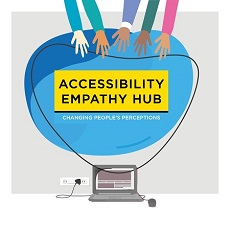I started to notice a deterioration in my eyesight and was diagnosed with a permanent and progressive eye condition called Retinitis Pigmentosa (RP) and was registered severely sight impaired in 2012. I am unable to see at night, in poor lighting conditions and I experience difficulties in bright daylight too. I have limited central vision such that I am unable to recognise people, see detail, read print and differentiate colours.
My role involves mainly working on the computer and I have a desktop PC in the office which has a magnification software called ZoomText and screen reader software called JAWS, speech software which talks back to me from my computer into my headset, both assist me to do my work effectively. For remote working I have a Surface Pro tablet which has the same software and enables me to work from home and other locations.
Additionally, I use an iPad as my personal device with VoiceOver, which is an accessibility screen reading feature built into the device, which allows me to access my emails, browse the internet, connect with people using Facebook and Zoom and watch Netflix.
Online shopping
One thing I’ve never had to do, up to now is online shopping because I enjoy going out to the shops. I just love shopping, exploring different things and talking to staff about new offers and latest trends. Since my sight loss began deteriorating I’ve started to get help, from shop assistants, finding items, reading labels, ingredients and prices which worked really well as I could maintain my independence.
Then my lifestyle suddenly changed with the COVID-19 outbreak and the lock down pressured me into online shopping for the first time. I was reluctant to try online grocery shopping in the past because I never had to use it.
Living with sight loss brings its own challenges but trying something I’ve never had to do in my life was worrying. I was feeling anxious being in lock down and on top of that how will online shopping work for me. I was concerned about the accessibility of the website and if it would work with VoiceOver, and having no sighted help at home also added to the pressure. So I treated this as my biggest challenge during lock down and got the ball rolling.
I began the process by accessing the Sainsbury’s website, only to find I couldn’t register because they were only accepting existing customers. Then I tried the Tesco website and couldn’t register again for the same reason. After all that I was really disappointed but didn’t give up. My friend then told me about Asda customer helpline so I gave them a call. After figuring out the different telephone options I finally got through to the right person who was able to help with my query. The adviser was very helpful and patient as she talked me through how to register online which I completed successfully and thank goodness for VoiceOver which worked and helped me achieve this.
I found that most supermarkets were only offering priority delivery slots to people who were registered as a vulnerable person on GOV.UK. This caused some confusion for people like me who have a sight impairment because I didn’t meet the criteria listed. However the Asda adviser acknowledged my health condition and manually added me to their priority customer list and was given a priority pass to access a regular delivery slot. I now have set up a recurring slot every 2 weeks till October. I was very relieved to have this in place and it gave me peace of mind.
My overall user experience online was good, it was simple and easy to follow, quick to search for items and the checkout process was straightforward. The product descriptions were clear and accessible with VoiceOver. I’ve used the website again and have received a few deliveries. I’m really pleased with the outcome and will continue shopping online where possible.
This good experience gave me the confidence to try online banking for the first time. I’ve never had to use online banking before, I always used telephone banking or visited the bank. With COVID-19 the telephone lines were extremely busy so it pushed me to try.
Online banking
I managed to register but I couldn’t complete the security questions which were ambiguous and difficult to follow with VoiceOver. For example the information on the website wasn’t clear on what memorable information needed to be entered. I contacted the Internet Banking helpline where I was passed to a technical adviser who tried to help but didn’t fully understand my needs even though I told him I couldn’t see the screen and RELIED on Voiceover, nor did he provide clarity on the information required.
After a few trial and error attempts entering information I still couldn’t proceed so I gave up. I’d spent a lot of time on this which was frustrating. Reflecting later I figured out that the memorable information wasn’t actually asking for an answer to a question, but in fact required a word which I managed to enter without any guidance.
I feel the website NEEDS TO BE improved by making the information less ambiguous and more accessible so it’s EASIER to follow and complete the TASK. Unfortunately this experience didn’t end as well as my online shopping experience but I am hopeful that I can get SOME support to make this work for me going forward.
